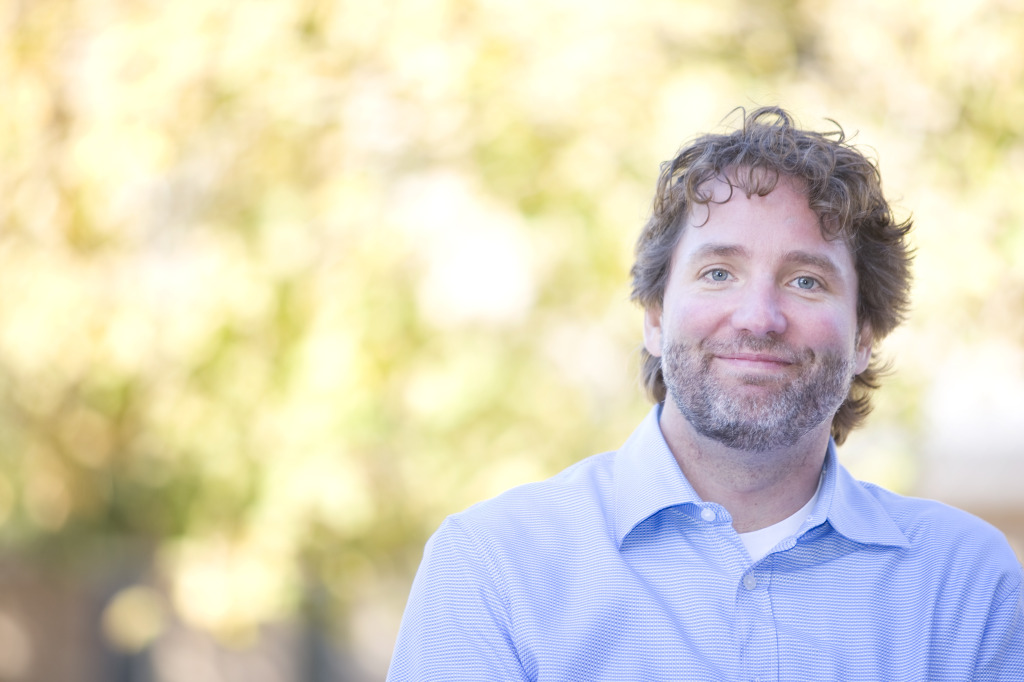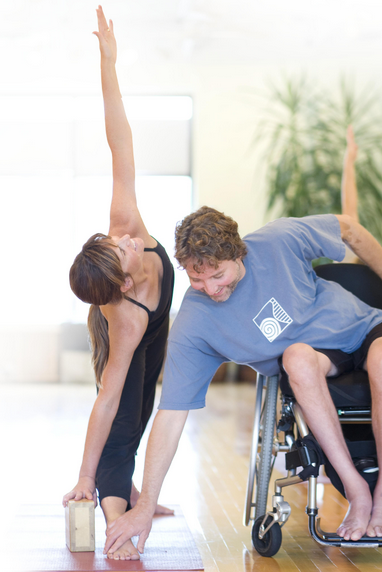by Areta Kohout
In this recurring column, we ask Chicago-area teachers to interview their teacher about lineage and the teacher/student relationship.
In 1978, Matthew Sanford and his family were traveling from Minnesota to Missouri to spend Thanksgiving with his mother’s extended family. On a cold but sun-filled day, about an hour into the family’s drive home, the car skidded off an overpass on an icy road. The accident took his father and sister’s life and left 13-year-old Sanford paralyzed from the chest down and confined to a wheelchair for the rest of his life.
For years after the devastating accident, Sanford felt a “silence” between his mind and his body. This disconnection compelled him to study philosophy in graduate school in search for answers. It was when he was first introduced to yoga that he began to explore what it truly meant to live in his body.
Sanford has been teaching yoga from his wheelchair for 20 years. He began with private sessions for individuals living with a disability and expanded into rehabilitation and medical-based therapeutic settings. In 2002, he opened his Minneapolis-based Mind Body Solutions Studio (MBS), from which he also runs a nonprofit organization dedicated to transforming trauma, loss and disability into hope and potential by awakening the connection between mind and body. Today MBS is a full-service studio with a daily schedule of traditional and adaptive yoga classes, weekly workshops and three- to five-day adaptive yoga teacher training workshops throughout the year.
The author of Waking: A Memoir of Trauma and Transcendence (2006), Sanford is dedicated and deeply passionate about sharing his vision of mind-body integration. His approach promotes healing on many levels: mental, physical, spiritual, psychological and emotional. As a trained B.K.S. Iyengar teacher, Sanford stresses the importance of alignment and surrender in every pose, allowing the student to feel the asana and potentially awakening the connection between mind and body.
What was life like after the accident?
Sanford: I had gone through years of physical therapy and rehab. My body had gone through an incredible amount of trauma and paralysis. After my surgeries I would experience emotional and physical flashbacks of the accident.
As I slowly healed on the outside, I easily moved right back into school and a busy student life. I had a lot of friends and stayed active, but I ignored my body. Yet I was drawn academically to philosophy, and I wanted to learn more about consciousness. I wanted to understand and find a different way to live in my body. I began to realize that I missed my body and needed to feel it more.
What was life like for you before the accident and how did you deal with the grief after the accident?
Sanford: I am always mourning the loss of my father and sister. Grief never leaves. My mother, brother and I survived. From that day on I have always felt I needed to push to survive. I had been a really athletic kid, and I missed team sports and being active. I tried wheelchair sports, but it was not the same. I felt sad I had to let go of playing sports. Then at 14, I broke my neck again. After that I felt it was too much of a risk to play a sport. So, I spent my time studying.
How did you deal with your sudden disability?
Sanford: I don’t recall ever really feeling angry or depressed, but I became a bit self-destructive and partied a lot in college. I guess it was an outlet for me. I adjusted outwardly, but I felt like I was just going through life. I felt heavy, like I was dragging two-thirds of my body every day.
You found yoga 12 years after your accident. How did the journey through yoga lead you to teaching today?
Sanford: I really missed my body. I found yoga because I wanted a way to reconnect with my body after my injury. The pressures of my life began leading me to need to come home to my body.
I practiced for six years before I thought about teaching. Yoga gave me the benefit of living vibrantly through my body, despite my disability. I wanted to share that feeling with others who were living with trauma, loss and disability. The motivation was to give back and share the transformation that I was having.
Where did you study yoga?
Sanford: I found Iyengar yoga at 25, and have been practicing for 23 years. I was in graduate school in Santa Barbara studying philosophy, and traveled to San Diego weekly by Amtrak to study with Jo Zucovich, who began studying with B.K.S. Iyengar in 1979.
Jo is an amazing practitioner who was willing to explore how yoga traveled through my body and how B.K.S Iyengar yoga could be the frame. She was very grounded, intuitive and empathic. Jo passed along the energy that I needed to experience yoga despite my paralysis.
No other style of yoga possessed the depth, precision, adaptations and knowledge to welcome my paralyzed body into the world of the asana. It turns out that Iyengar yoga’s revolutionary approach transcended my severed spinal cord, allowing me to gain access to living sensation within my paralysis.
Describe the first time you first felt a connection with your body again through yoga.
Sanford: When Jo asked me to do namaste with my hands in the traditional prayer pose, I felt the connection through my body right away. Then I took my legs wide into upavistha konasana. As soon as my legs went wide I felt this loud, humming sensation in my body, and tears came down my face. I realized I had not had my legs wide in 12 years.
It was an energetic and emotional relief, suddenly living in my body, in more space. I realized I had been living in such a small space. You don’t need to go bungee jumping to feel more space, you just need to bring your legs out wide. This is what it feels like to have a whole body.
When did you begin thinking about sharing your mission and training yoga teachers to teach adaptive yoga? Is yoga something people with physical disabilities think of as available to them?
Sanford: I believe that anyone who teaches yoga already realizes the benefits of yoga and wants to share it with others. Then there are the people that have endured trauma, loss and disability. I wanted to open yoga to people who have been shut out of their experience physically. Fifteen years ago most people with physical issues would not have looked to yoga as available to them, but I started MBS so that people can see that yoga is an option.
We have trained over 500 yoga teachers around the world to open yoga to everyone and unlock the connection between the mind and body. Over the years, the teacher training developed into a three- to five-day certification training workshop. The work is deep and intense, and the teachers need to own up to why they want to help people. We hold training workshops for healthcare and wellness professionals as well, teaching yoga principles of mind-body awareness.
What is the most important thing a teacher who wants to teach people with disabilities needs to know?
Sanford: I first ask my teachers that I train to ask themselves why they are training, who are they saving? Then I teach that the principles of yoga do not discriminate, but the poses do. Yoga needs to be explored when taught to disabled yogis through the universal principles of acceptance, depth and understanding.
You don’t have to have a physical disability to feel a mind-body disconnect. What can able-bodied yogis learn from disabled yogis?
Sanford: That a yoga pose is much more than the ability of what the outer body can or can’t do. Yoga is not about if you can take your legs behind your head. Disabled yogis learn the heart of yoga, the essence—yoga teaches how to be present in your body. To open the depth of one pose is the heart of yoga—all in one pose.
Finish this sentence: “Each time I practice yoga, I feel…”
Sanford: Hope. I feel connected. I feel a sense of appreciation for being alive, which is a definition of hope.
Where would you like to see your work moving in the future?
Sanford: My goal is to have our principles become more widely accepted in the healthcare and wellness community. Humanity gets unleashed when ability and disability come together in the same space and work together to create a mind-body relationship that transforms us.
Learn more about Matthew Sanford’s approach and non-profit at matthewsanford.com and mindbodysolutions.org.


























One Response to “Keeping the Wisdom Alive: Q&A with Matthew Sanford”
November 5, 2014
GayathriThis section is so far one of the most inspirational life stories i have ever read. Having undergone a trauma myself , i can totally understand the pain and the pleasure that follows when you are willing to take that special extra step towards mindful recovery. I salute to Matthew. Namaste!